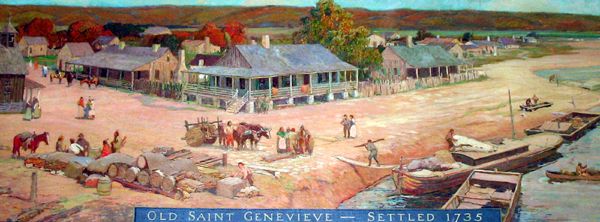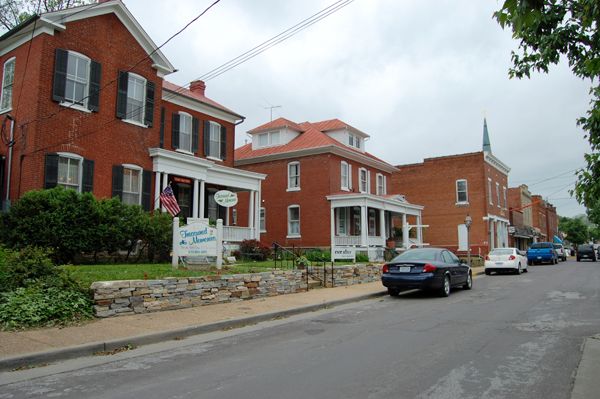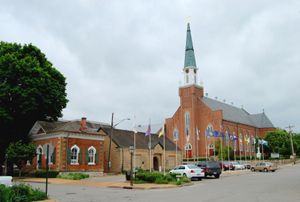The county seat of Ste. Genevieve County, Missouri, Ste. Genevieve is one of the oldest surviving French settlements in Missouri. She is the only place in the upper Mississippi Valley where several buildings of the pre-American period have survived. Today it is one of the newest National Parks.
The oldest European settlement in the region, Cahokia, established in 1699, suffered heavily from floods; Kaskaskia (1703) was entirely washed away by a change in the course of the Mississippi River; the remnants of colonial St. Louis were destroyed either by a fire in 1849 or by urban riverfront development.
Though the exact date of the first French settlements near Ste. Genevieve cannot be determined, it is known that lead was discovered about 30 miles to the southwest of the townsite in 1715. During the first portion of the eighteenth century, no urgent need existed to extend the line of French settlement across the Mississippi River into present-day Missouri. For several decades, the French considered the trans-Mississippi West the domain of Native Americans. As the century progressed, however, farming practices resulted in soil depletion on the east side of the river, and some inhabitants decided to plant crops on the opposite side, about three miles below present-day Ste. Genevieve.
During its first few years of settlement, in 1735-40, Ste. Genevieve was a satellite community of Kaskaskia, Illinois, across the river. The earliest land grants were made in 1752 when 27 inhabitants owned about three miles of the Mississippi River frontage. It was named for Saint Genevieve (who lived in the 5th century AD), the patron saint of Paris.
The earliest settlers of the community moved there from other settlements in Illinois, including Kaskaskia, Cahokia, Post Vincennes, Prairie du Rocher, and Nouvelle Chartres. Salt springs on Saline Creek and the lead resources were probably an important factor in the expansion of the settlement, from which shipments were made upstream to St. Louis or downstream to New Orleans. The settlers also grew foodstuffs for export. Ste. Genevieve was the last community established during the French Regime in the Illinois Country.
The inhabitants’ French heritage influenced the pattern of initial settlement. The heart of the Ste. Genevieve economy was a large compound of arable fields known as le Grand Champ or the Big Field. It consisted of approximately 7,000 acres of land enclosed within a common fence. The parcel was divided into narrow, elongated lots often delineated by pecan trees that extended westward from the Mississippi River. Each lot contained between 68 and 136 acres of land. Orchards and extensive gardens with all manner of vegetables and fruits filled the remaining portions of the land within the fence.
Ste. Genevieve’s commercial contacts were maintained mainly through New Orleans, Louisiana, and were dominated by the mercantile policies of France and Spain. The community exported raw materials and imported finished products. Looms and weavers, for example, were absent in the town because the colonial community was obligated to purchase manufactured cloth from the mother country.
In about 1750, the “official” village of Ste. Genevieve was laid out as an imperfect grid of square blocks with a public square near the center of the village. By 1752, the population of Ste. Genevieve is recorded to have included 22 white adults and children and two black slaves. Following the Seven Years’ War (1754-1763), Ste. Genevieve’s population increased significantly. The population increase is attributed, in part, to the influx of French Catholics from the east bank of the Mississippi River who feared religious and political persecution at the hands of the British following France’s loss of that territory to England. Although the city’s economy depended on agriculture, industries began to develop, and the central business district grew. The 1773 census indicated a population of 676, of which 276 were African Americans.
Floods, notably one in 1785, caused repeated damage, and the town was moved gradually to the present site on high ground. By 1796, only a few traders’ huts remained at the old site. Ste. Genevieve, the principal seat of government in the region for many years after western Louisiana passed from French to Spanish control in 1762, thrived under Spanish administration.
During the 1780s and 1790s, about forty percent of all households in Ste. Genevieve owned at least one black or mulatto slave. These slaves were used for various tasks, including fieldwork, clearing land, cutting wood, mining lead, rowing batteaux, salt making, domestic help, and some skilled labor because of the economy of Ste. Genevieve revolved around agriculture; black slaves were primarily agricultural laborers. The censuses of 1787 and 1791 indicated that the town’s six agricultural producers owned about one-half of its black and mulatto slaves.
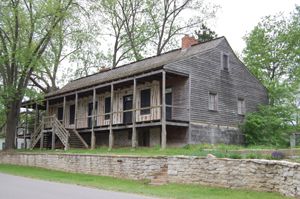
The Janis-Ziegler House, or Green Tree Tavern, in Ste. Genevieve, Missouri, was probably built in the 1790s. The house combines French and American architectural styles by Kathy Alexander.
Present documentary and physical evidence indicate that the oldest known architectural resources, French vertical log houses, date from the 1790s. In that same decade, the plat of the core of the present city was laid out between the forks of Gabouri Creek. Surviving buildings from this era reflect the original French heritage of the community, the influx of Anglo-American settlers, the settlement patterns in the African American community, and the beginning of an influx of German immigrants.
In 1789 Nicolas Janis was granted land in Ste. Genevieve and erected the present-day Janis-Ziegler house in about 1790-91. With the death of Nicholas, his son, François, inherited the house and, in the early 1800s, converted part of it into the Green Tree Tavern. The building remained in the Janis family until 1833, when it was sold to Mathias and Barbara Ziegler. It is the oldest standing structure in the city today.
In 1793, the old Ste. Genevieve Catholic Church was disassembled from the first townsite and moved to present-day Ste. Genevieve. In 1831, a stone church on the same site replaced the vertical log church. In 1876, construction of the present church began around the stone church, and the stones from the former church were removed. The 1876 church continues to stand, displaying its clock tower and steeple that rises 193 feet above the street level and houses four massive bells that chime throughout the day. It continues to serve a congregation today.
In 1800, the population was estimated at 1,163, of which 350 were African American and mulatto. Ste. Genevieve’s importance declined after the Louisiana Territory was passed to the United States in 1803, and St. Louis became the area’s principal port and commercial center.
One of the most important events in the early 19th century was the establishment of the Louisiana Academy. This institution may have been the first public school west of the Mississippi River. The Academy was organized in a meeting of subscribers in September 1807. Father James Maxwell was chosen as chairman of the Academy’s Board of Trustees. From the beginning, Maxwell planned an academy where instruction was given in French and English. The Academy began instruction in 1810 and welcomed area settlers and Native American and black students. Today, the building continues to stand as a private residence.
In 1812, Missouri became an official territory with a governor and general assembly. The County of Ste. Genevieve was established as one of the five original territorial districts. In the town’s early years, before the formation of an island on the western side of the Mississippi River, boats could moor at the foot of the town streets. In 1817, the steamboat Pike tied up at Ste. Genevieve.
During these years, Ste. Genevieve experienced moderate growth as Anglo-Americans and Germans moved to the community. By the second quarter of the 19th century, the French-speaking population and the French language were losing their hold on the city. New buildings were erected in American and German styles. A sizeable influx of Germans into Missouri began in the 1840s, with German settlements concentrated in an arc along the Missouri and Mississippi Rivers, including New Madrid, Cape Girardeau, and Ste. Genevieve. During this period, the most recently built French vernacular dwelling, the Jean Baptiste Birke House, was built in 1846.
The first significant effort to diversify the community’s economy beyond farming occurred in the mid-19th century. Enterprising local investors viewed the town’s future as linked to the mines located further west. If efficient means could be developed to bring products of the mines to the Mississippi River in Ste. Genevieve, the town could develop as a major river port. In 1851, the construction of the Ste. Genevieve, Iron Mountain, and Pilot Knob Road began. Completed in 1853, the 42-mile-long thoroughfare was the longest plank road in the United States. It had five toll gates and was used primarily to haul iron ore; however, other materials transported included marble and granite from quarries and agricultural products. For a brief period, Ste. Genevieve became a major Mississippi River port, serving as the shipment point of the products of the mines to the west. Just four years after the road was completed, it was made obsolete by the completion of the Iron Mountain Railroad, which, unfortunately for Ste. Genevieve diverted much of the produce and traffic to St. Louis.
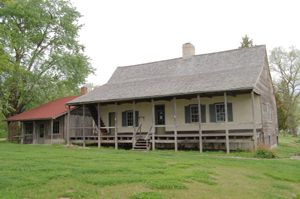
The Beauvais-Amoureux House was built in 1792 by Jean Baptiste St. Gemme Beauvais,
Jr. overlooking le grand champ, the agricultural fields of Sainte Genevieve. The home was constructed in the French creole vernacular post in the ground (poteaux-en-terre), the manner that was common in the 18th century in Ste. Genevieve.
By 1860, the majority of heads of households in Ste. Genevieve were of German birth or ancestry. A significant minority (34.8%) were Missouri-born French, with the remainder of the population consisting of Anglo-Southern whites, a smaller number of northern whites, and enslaved and free African Americans. The large proportion of French and German residents differentiated Ste. Genevieve from the surrounding countryside and nearby communities. In these areas, the majority of the population was Anglo-Southern.
With the Emancipation, any enslaved African Americans who remained in Ste. Genevieve were freed. Several African American communities developed in and around the town. The only such community still represented by standing buildings is that on St. Mary’s Road in the vicinity of the South Fork of the Gabouri Creek. Two residences remain from the community at 309 St. Mary’s Road and the Brooks House at 311 St. Mary’s Road. Both are two-story, wood-framed vernacular house types placed on raised foundations, and both were erected during the second half of the nineteenth century. A third property historically associated with the African American community is the Lincoln School on Washington Street. This school, built in about 1860, served as the community’s only African American public school between about 1894 and 1929.
For much of the second half of the 19th century, Ste. Genevieve’s economy continued to be dominated by agriculture. In 1876, the town boasted a grocery store, a watchmaker and jeweler, a banker, two boot and shoe manufacturers, a tailor, an attorney, a tin shop, a stove, and tinware store, a dressmaker, a general merchandise store, and a hotel.
In 1876, work began on constructing the present Gothic Revival Catholic church. Services continued in the earlier rock church as the new brick building was built around and over it. The rock church was eventually dismantled, but its foundation is still visible in the present church basement. The new church, which still dominates the city’s skyline, was dedicated in 1880 and cost $24,000.
A review of advertisements in an 1879 issue of the local newspaper, The Fair Play, listed additional businesses, including John L. Bovarie’s drygoods store, Joseph Vorst’s People’s Hack Line, C.W. Hamm’s Clothing Store, and the Ste. Genevieve Livery, Feed, and Sales Stables; Leo Jokerst’s Union Hall, a saloon and a dancing hall; as well as several professionals including several attorneys; real estate agents; a surveyor; druggists; a dentist; a physician; two barbers, a painter, and an architect.
By the 1880s, Ste. Genevieve sported several industrial businesses, including the Ste. Genevieve Brewery, Cone Mills, and a barrel maker. In 1894, local businesses included three meat markets, three saloons, two bakeries, two cobblers, a blacksmith, a wagon shop, two grocery stores, a jeweler, a drug store, two restaurants, a notions shop, four general stores, a livery, harness shop, furniture and cabinet shop, an agricultural implements warehouse, a hardware and tin shop, a lumberyard, a barber, an undertaker and more. The city also boasted two hotels – The Southern Hotel and Meyers Hotel. Civic buildings included a post office, the county courthouse and jail, a public school, and an unfinished Catholic school building.
An 1897 letter to the editor of the Ste. Genevieve Herald stated: “Without a railroad, Ste. Genevieve must pass into history, a relic of the past”. This deficiency was rectified at the turn of the century when the Illinois Southern Railroad was constructed in 1901. This line, which later became part of the Missouri-Illinois Railroad, provided service into the Lead Belt area of St. Francois County, west of Ste. Genevieve. The St. Louis and San Francisco Railroad established a line along the west shore of the Mississippi River and connected Ste. Genevieve to many cities to its south. In 1904, the Illinois Southern Railroad began operating a ferry at Little Rock Landing north of Ste. Genevieve to carry railroad cars across the Mississippi River to Kellogg, Illinois. The transfer ferry operated until 1961. The landing was also used for river transportation of the city’s products.
In 1900, the city had a population of 1,707. In the first decade of the twentieth century, the population grew to 1,967.40, primarily driven by the expansion of the lime industry, including the establishment of the first large-scale lime production company in the community. However, agriculture remained a prominent part of the economy of Ste. Genevieve and vicinity in the first decade of the twentieth century. Commercial facilities included two flouring mills, two cigar factories, and an ice plant. Beginning in the 1920s, industrial and population growth of the city increased again when four lime companies established operations in and around Ste. Genevieve. The growth of industry necessitated the growth of housing. Neighborhoods platted decades before were developed with houses in then-popular styles and forms, such as the American Foursquare and the bungalow. By 1930, the number of residents had increased to 2,662.
The railroad continued to be important in the 1920s and 1930s. A 1932 report indicated that “excellent passenger service: was maintained on the St. Louis-Memphis branch of the St. Louis and San Francisco Railroad. Passenger service was provided by all-steel coach, diner, and Pullman cars drawn by oil-burning locomotives. Four passenger trains stopped daily in Ste. Genevieve and freight service was provided by six daily trains, three in each direction.
The Great Depression slowed both the economic and population growth of the city. Due to the economic downturn and labor strife, the city’s limestone producers were forced to consolidate. During the 1930s, the population increased to 2,767.
With the end of the Second World War and the return of veterans to their home communities to find civilian jobs and start families, the city’s population growth again accelerated. The 1950 population was 3,992. The city expanded its boundaries southward to accommodate this growing population, and new subdivisions began to be developed. Manufacturing, wholesale and retail trade, transportation, communications, and other public utilities were the largest employment sectors. Agriculture, the historical mainstay of the city’s economy, employed less than two percent of its residents.
Today, a visit to Ste. Genevieve is a step back in time, where visitors may visit French-colonial homes, a museum, and a downtown historic district filled with unique specialty shops, cafes and restaurants, antique stores, and art galleries. The city is called home to about 4,500 people. Approved by Congress in March of 2020, Ste. Genevieve officially became the 422nd National Park in late October 2020.
More Information:
Ste. Genevieve Tourism
66 South Main St.
Ste. Genevieve, Missouri 63670
800-373-7007
Compiled & edited by Kathy Alexander/Legends of America, updated June 2023.
Also See:
Cape Girardeau Forts and the Battle of Cape Girardeau
The Mississippi River and the Expansion of America
Source: National Register of Historic Places Multiple Property Documentation

